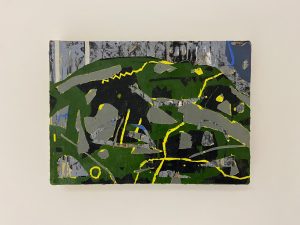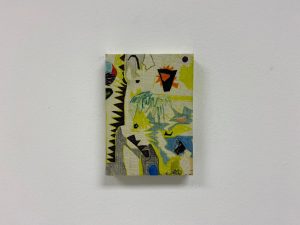What is your typical studio routine?
I try to go into the studio at least 2-3 times a week. I am more of a evening/late night painter. I have always found I work better in the evenings. I am not sure if it is because everywhere seems quieter at night or that it takes that long for my brain to wake up and start feeling creative.
I like to do long days in the studio when I can, just because when I get into the zone of working I never really want to leave it, unless a painting is going horribly wrong. When I get to the studio it can take me up to an hour to settle in. I look at what I have done the last time I was in, I eat some snacks, maybe make myself a cup of tea and then when I feel more relaxed I put some headphones in and start working. I never go in with a concrete plan of what I am doing. I like to assess and see how I feel when I get there. I work on a lot of small paintings at the same time, because it lets me test things out and I don’t feel like I have to be too precious with anything. I tend to start something, then end up doing something completely different. I like to see where the work takes me. I do have different ideas going on in my head about what I want from my work, but I am usually quite flexible with how they transfer out onto canvas – as I have found if I try to force or plan out an idea too much, it never really turns out to be that good or that interesting. I work until I get too tired or hungry or most times up until the studios close and I have to leave.
How do you describe your practice?
My practice explores how we interact and use landscapes, and spaces that we inhabit. I am particularly interested with environments that are assumed to be ‘natural’, but rather are constructed and have an artificial quality to them.
I explore these ideas mainly through the medium of paint, however my starting point for most of my work is from onsite drawings within the landscape. I make quick sketches marking out different information that I see using pencils, coloured markers and charcoal. Drawing has become more central to my practice and how it is then translated into painting, back in the studio, through mark making, line, form and shape.
In my practice I tend to work intuitively with colour and with an openness to how a painting develops. By working across multiple canvases or boards at once, it helps me to keep my practice quite experimental. This way of working allows me to explore the idea of a falseness to the landscape, alongside the questioning of what is ‘natural’? or what is perceived to be ‘natural’?
Is there a particular process or methodology within your practice that is important to you?
As I briefly mentioned above, drawing has become really important within my practice as it is my initial starting point for generating ideas for my work. I think also the event of drawing has become really important to me. I have to physically go to a location and draw. It can definitely be hard at times forcing yourself to go out and draw in the cold and wet, but it always feels very rewarding bring a drawing home again (even if it’s a bad one). I find when I am struggling with painting or ideas in the studio, or if I have hit a standstill in my work and do not know how to progress, I use the process of drawing as a way to reset or refresh things. It helps me generate new ideas or new ways of looking.
How long have you been working as an artist?
I graduated from Belfast School of Art in 2020 with a BA (Hons) in Fine Art. I went on to become the painting Graduate in Residence for the BA Fine Art course for 2020-2021, which allowed me to continue to practice and make work after graduating. I then was lucky enough to get a studio space in QSS in September 2022. It has only been since getting the studio at QSS that I have felt like a practicing artist, I think having a space to call your own is so important as an artist. Having tried working from home before I got my studio space, I have really noticed the difference in having it. I am still quite early on in my art career so I’m looking forward to making more work and seeing what happens.
Is it difficult being back in the studio after an exhibition?
For me, is it not. I am always quite keen to get back into the studio and push on with ideas. I look forward to making new work, better work, trying different ways of working and developing my paintings further.
Describe how important art is to society?
I find it fascinating how everyone can look at a piece of art and have so many different opinions, feelings and emotions towards it and I think that is needed in society. I also think without art life would be a lot more dull.
What do you dislike about the art world?
At the minute I really dislike how expensive oil paint is.
What is the best advice you have been given as an artist?
The best advice I have received is probably to just keep on making the work. Even if it is bad. I remind myself of this a lot in the studio, to just keep making, because something will always come out of it or it will lead on to something else, or parts of things will come together. I like how the tiniest of things from one piece of work can shift the direction of your practice, you never know what the outcome will be in the studio or where the work will lead, but that is the exciting thing. It is all part of the creative rollercoaster.
What jobs have you done, other than being an artist?
I have been a customer advisor, a waitress/ barista, a dog sitter, a babysitter, a kitchen porter and I am currently a part time farm shop assistant. It is tuff to survive financially solely as an artist, and I don’t think I could cope with that pressure on my work. I always remember getting told back in university that you get a job on the side to fund the art and make it work.
About Rebecca:
Rebecca Dawson (b. 1997) is an artist from Straid, currently based in Belfast.
Dawson graduated from the Belfast School of Art in 2020, receiving a First Class Honours in Fine Art, specialising in painting. She then went on to become the painting Graduate in Residence for the BA Fine Art course at Belfast School of Art (2020-21).
Recent exhibitions include ‘Portrait of Northern Ireland: Neither an Elegy nor a Manifesto’ at the Golden Thread Gallery (Belfast, 2021), ‘Emerging Artists 2021’ at Roe Valley Arts and Cultural Centre (Limavady, 2021) and ‘Ulster University BA and MFA Fine Art Graduate Show’ at the MAC (Belfast, 2020).
Dawson’s practice explores how we interact and use landscapes, and spaces that we inhabit – particularly with environments that are assumed to be ‘natural’, but rather are constructed and have an artificial quality to them. Her ideas are explored primarily through the use of paint, however the starting point for most of her work is from on site drawings within the landscape. Dawson wants to create an underlying artificiality in her work, be this through her choice in imagery, colour, composition, form or through the embedding of things into the surface of the paint. She seeks to explore this idea of a falseness to the landscape, alongside the questioning of what is ‘natural’? or what is perceived to be ‘natural’?
Instagram : @rebeccadawsonartist
Website : Rebecca Dawson

Untitled Drawing, 2022, Pencil, markers on paper, 21 x 30cm

Untitled Drawing, 2023, Pencil, markers on paper, 21 x 30cm

Mound, 2023, Oil on canvas, 21 x 31cm

Orange Spikes, 2022, Pencil, markers on tape, mounted on board, 13 x 18cm

